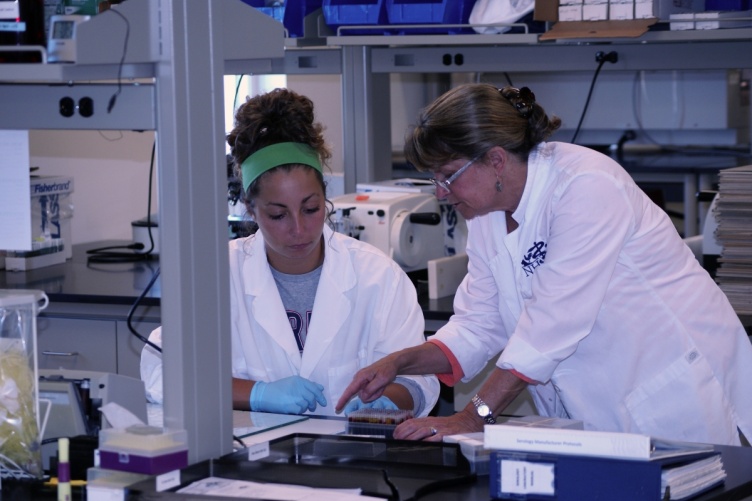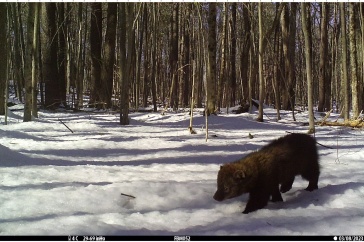
Student employment at the NH Veterinary Diagnostic Lab, which is housed at UNH, also offers a different perspective on veterinary careers and allows students to interact with the laboratory technicians and three veterinary pathologists on staff.
Prospective veterinarians hoping to get into one of the nation’s handful of schools of veterinary medicine would be wise to do their pre-vet coursework at the University of New Hampshire: UNH graduates are being admitted to schools of veterinary medicine at a high rate – well above the nation average of about 50 percent.
In the most recent academic year, 88 percent of the UNH students who applied to veterinary medical school were admitted. In 2015, 79 percent who applied were admitted; in 2014, 80 percent who applied were admitted; and in 2013, 100 percent who applied were admitted. While admittance rates vary by veterinary medical school, the national average is about 50 percent.
According to the Association of American Veterinary Medical Colleges, veterinary medical school is very similar in academic rigor to medical school. There are 30 accredited colleges of veterinary medicine in the United States, each graduating about 100 students per year. While there are also accredited veterinary medical schools abroad, most UNH students attend veterinary medical school in the United States.
According to Dr. Inga Sidor, director of the UNH Pre-Veterinary Advising Program, clinical associate professor of molecular, cellular, and biomedical sciences, and senior veterinary pathologist at the NH Veterinary Diagnostic Laboratory (NHVDL), UNH’s extensive hands-on research experience and relevant animal courses give prospective veterinary medical school applicants an advantage over graduates from other pre-veterinary programs. Students who are successful being accepted to veterinary medical school frequently have 400 to 500 hours or more of experience in veterinary clinics or biomedical research laboratories.

The Cooperative Real Education in Agricultural Management (CREAM) course in the UNH College of Life Sciences and Agriculture is particularly valued by students and veterinary medical schools for giving large animal experiences to students who might not have grown up with exposure to large animals. CREAM is a student-run cooperative in which 25 UNH students, with the help of advisors, operate and manage a small business – a herd of 25 to 30 registered Holstein dairy cattle. Students milk, feed, and care for the herd every day of the school year, and also do outreach activities for the college and general public.
“We have heard from students returning from vet school interviews that CREAM has a very good reputation – students not involved in that program are asked ‘why not?’” Sidor said.
Student employment at the NH Veterinary Diagnostic Lab housed at UNH also offers a different perspective on veterinary careers and allows students to interact with the laboratory technicians and three veterinary pathologists on staff. The lab is co-funded and co-managed by the New Hampshire Department of Agriculture, Markets & Food and the UNH College of Life Sciences and Agriculture. The lab assists the New Hampshire Commissioner of Agriculture and State Veterinarian in their efforts to monitor and control important animal diseases. The lab also provides diagnostic services to hundreds of veterinarians from New Hampshire and New England who use the lab’s histopathology, microbiology, serology, and necropsy services for the diagnosis of animal diseases in pets, farm animals, wildlife, zoo and marine animals.
“Paid work at the NHVDL is different than work at a veterinary clinic, and teaches the skills of laboratory work, attention to detail, accountability, and teamwork. The Grand Rounds course, where students observe and participate in necropsies of animals submitted to determine cause of death, is another unique introduction to the fundamentals of anatomy, physiology and disease offered through the NHVDL. And access to the large number of NHVDL client clinics allows us to recommend opportunities for our students to get off-campus experience,” Sidor said.
The availability of many on-campus veterinarians as faculty advisors also improves UNH’s acceptance rate. Faculty members represent a variety of expertise in a number of distinct fields, from pathology to equine, dairy, small animal and lab animal medicine. “We can speak with students about the realities of both preparing for veterinary school and being practicing veterinarians. We have the opportunity to guide students from early in their education – both in recommending ways to enhance their academic program and experience, or to gently guide them towards other, more suitable, opportunities,” Sidor said.
UNH’s overall focus on undergraduate research provides many of its successful candidates for veterinary medical school a solid research experience, proving that they have potential to be not only successful veterinarians, but scientists as well.
“In the end, it is the students who do the work to get into veterinary school. It is hard work, and requires determination and passion to choose the difficult courses, study through sunny afternoons and late into the night, and rise early for a vet assistant job or barn shift. We give them the tools and opportunities, but they must make the effort to take advantage of these options,” Sidor said.
“Our most successful students have not only performed well in class, but have been involved in more than one research experience, internship, study abroad program, mentorship program, or other academic ‘extra.’ Their efforts are recognized by the schools to which they apply and where they are accepted. We are very proud of what our students accomplish,” she said.
Founded in 1887, the NH Agricultural Experiment Station at the UNH College of Life Sciences and Agriculture is UNH’s original research center and an elemental component of New Hampshire's land-grant university heritage and mission. We steward federal and state funding, including support from the USDA National Institute of Food and Agriculture, to provide unbiased and objective research concerning diverse aspects of sustainable agriculture and foods, aquaculture, forest management, and related wildlife, natural resources and rural community topics. We maintain the Woodman and Kingman agronomy and horticultural farms, the Macfarlane Greenhouses, the Fairchild Dairy Teaching and Research Center, and the Organic Dairy Research Farm. Additional properties also provide forage, forests and woodlands in direct support to research, teaching, and outreach.
-
Written By:
Lori Tyler Gula, PhD | NH Agricultural Experiment Station | lori.gula@unh.edu | 603-862-1452



















































